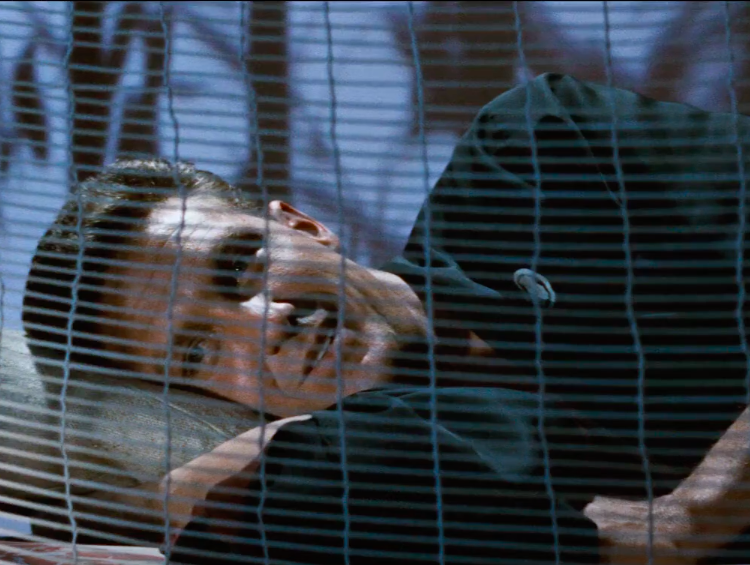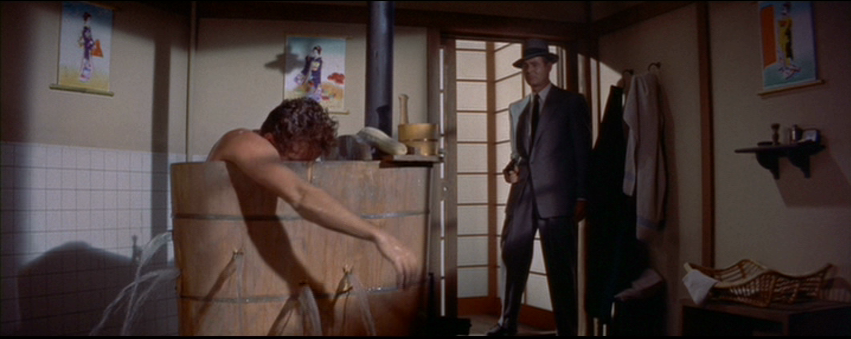
Planted in a Tokyo crime syndicate to probe the death of a fellow Army official, U.S. Army Investigator Eddie Kenner goes undercover as Eddie Spannier to find out more about the syndicate’s leader: local American gangster Sandy Dawson.
“Mt. Fuji in the background is House of Bamboo’s introductory image, snow-capped and serene, a travelogue shot; then, a few moments later, the same mountain is viewed from the vantage point of the scene of a crime by a ground-level camera, framed through the outstretched feet of a murdered soldier: Samuel Fuller in Japan, like tabloid ink sprayed on kakejiku scrolls. Tokyo in 1955 is noticeably the same one filmed concurrently by Ozu and Naruse, but it's also something of an open city, the war a fresh memory and the American Occupation fresher still, with glimpses of the wharfside shanties–anxious worlds barely afloat–Nagisa Oshima would explore in Taiyô no hakaba [The Sun's Burial, 1960]. Into it stomps agent of mystery Robert Stack, who's such a truculent Yank that, rather than taking in the rooftop rehearsal of a Noh troupe or the awe-inspiring tracking shot that captures the CinemaScope sprawl brimming with movement, he merely barks ‘Does anybody speak a little English?’ Fuller, on the other hand, is alert to the crossroads of tradition and modernity in which this combat film (disguised as an exotic policier) is set, pointedly balancing Stack's tentative romance with a widowed ‘kimono gal’ (Shirley Yamaguchi) with his submerged romance with the coolly vicious head of a racketeering gang of ex-GIs (the great Robert Ryan). Like the stately fan dance that suddenly segues into a jitterbugging shindig, the film’s portrait of a ruthless, businesslike crime system is a wicked fusion of America and Japan that's contrasted with the protagonist's redemptive interracial affair, and an example of the iconoclastic filmmaker's ribald eye for cinematic collisions of characters and forms.”
Fernando F. Croce1

Eric Sherman and Martin Rubin: Like The Steel Helmet (1951), House of Bamboo is essentially a love story between two men, Robert Stack and Robert Ryan.
Samuel Fuller: Definitely. That's epitomized by one line of dialogue that I gave Ryan. It comes right after the first robbery. Ryan is trying to figure out why, in Stack’s case, he [Ryan] broke his gang's policy of killing wounded men so that they won’t talk to the police. First, he says to Stack, “I don’t know why I saved your neck.” Then he turns to the other men and says, “Will anyone please tell me why I did it”. That's the big line, the cementing between them. I hoped it would get people a little nervous, because it's usually a line that a man says about a woman: ‘Why did I marry her? What am I doing with her? Why did I go out with her? Will anyone please tell me why I did it?’. That's as close as I could get to it, when Ryan says that line.
Eric Sherman and Martin Rubin in conversation with Samuel Fuller2

- 1Fernando F. Croce, “Samuel Fuller's ‘House of Bamboo’,” MUBI Notebook, 27 August, 2011.
- 2Eric Sherman and Martin Rubin, The director’s Event: Interviews with Five American Film-makers (New York: Atheneum Books, 1970). Reprinted by permission of Eric Sherman and Martin Rubin in: Samuel Fuller. Interviews, ed. Gerald Peary, (Jackson: University of Mississippi Press), 2012, 24.

